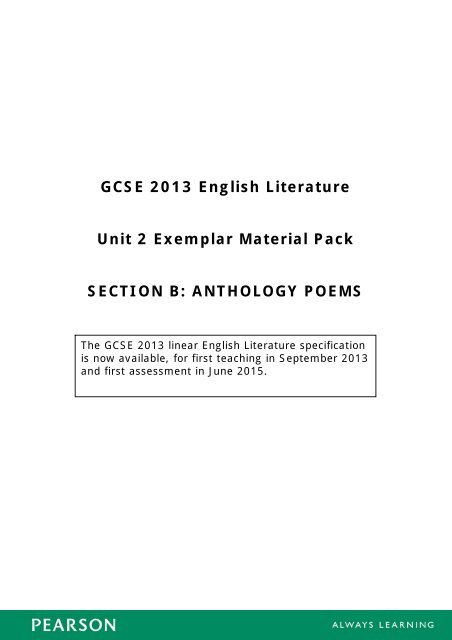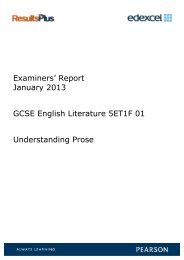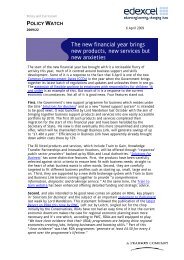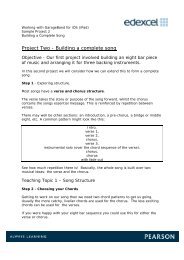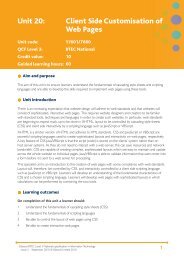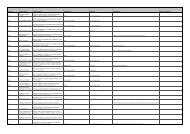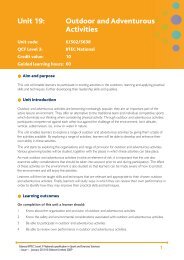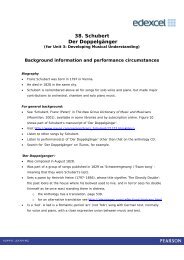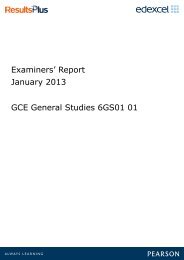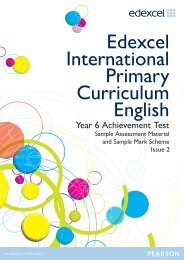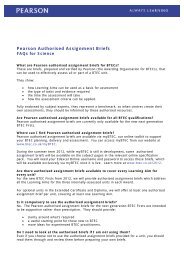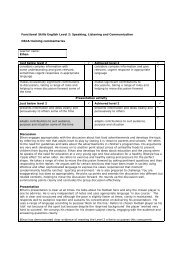GCSE 2013 English Literature Unit 2 Exemplar Material ... - Edexcel
GCSE 2013 English Literature Unit 2 Exemplar Material ... - Edexcel
GCSE 2013 English Literature Unit 2 Exemplar Material ... - Edexcel
You also want an ePaper? Increase the reach of your titles
YUMPU automatically turns print PDFs into web optimized ePapers that Google loves.
<strong>GCSE</strong> <strong>2013</strong> <strong>English</strong> <strong>Literature</strong><br />
<strong>Unit</strong> 2 <strong>Exemplar</strong> <strong>Material</strong> Pack<br />
SECTION B: ANTHOLOGY POEMS<br />
The <strong>GCSE</strong> <strong>2013</strong> linear <strong>English</strong> <strong>Literature</strong> specification<br />
is now available, for first teaching in September <strong>2013</strong><br />
and first assessment in June 2015.
Introduction<br />
The following exemplars are responses to the <strong>GCSE</strong> <strong>Literature</strong> Sample<br />
Assessment <strong>Material</strong>s which support the revised <strong>2013</strong> <strong>Literature</strong> specification.<br />
On both tiers, there is one question per collection which assesses AO2 for<br />
15 marks and AO3 for 15 marks.<br />
The foundation tier candidates in this pack have responded to questions on<br />
the Relationships; Somewhere, Anywhere; and Clashes and Collisions<br />
collections.<br />
Collection A: Relationships<br />
Compare how the writers of ‘Sonnet 116’ and one other poem of your<br />
choice from the ‘Relationships’ collection, present thoughts and<br />
feelings about love.<br />
You must consider:<br />
• the language and organisation of the two poems<br />
• similarities/differences between the two poems.<br />
Use evidence from both poems to support your answer.<br />
Collection B: Clashes and Collisions<br />
Compare how the writers of ‘Catrin’ and one other poem of your<br />
choice from the ‘Clashes and Collisions’ collection, present ideas<br />
about conflict in any setting.<br />
You must consider:<br />
• the language and organisation of the two poems<br />
• similarities/differences between the two poems.<br />
Use evidence from both poems to support your answer.<br />
Collection C: Somewhere, Anywhere<br />
Compare how the writers of ‘Upon Westminster Bridge’ and one other<br />
poem of your choice from the ‘Somewhere, Anywhere’ collection,<br />
present ideas about a particular place.<br />
You must consider:<br />
• the language and organisation of the two poems<br />
• similarities/differences between the two poems.<br />
Use evidence from both poems to support your answer.
The higher tier candidates have responded to questions on the<br />
Relationships; Clashes and Collisions; and Taking a Stand collections.<br />
Collection A: Relationships<br />
Compare how the writers of ‘Sonnet 116’ and one other poem of your<br />
choice from the ‘Relationships’ collection, present attitudes to love.<br />
Use evidence from both poems to support your answer.<br />
Collection B: Clashes and Collisions<br />
Compare how the writers of ‘Catrin’ and one other poem of your<br />
choice from the ‘Clashes and Collisions’ collection, present the theme<br />
of conflict in any setting.<br />
Use evidence from both poems to support your answer.<br />
Collection D: Taking a Stand<br />
Compare how the writers of ‘Remember’ and one other poem of your<br />
choice from the ‘Taking a Stand’ collection, present their reflections on<br />
an emotional experience.<br />
Use evidence from both poems to support your answer.
Foundation Tier
Script A – Somewhere Anywhere<br />
A brief but relevant<br />
introduction which<br />
immediately looks for<br />
links and comparisons<br />
between the two poems<br />
and introduces the<br />
chosen poem.<br />
William Wordsworth and William Blake both write about London in their<br />
poems ‘Composed Upon Westminster Bridge’ and ‘London’ but their views<br />
on the city could not be more different.<br />
Wordsworth describes London at sunrise, and he compares London<br />
to the most beautiful landscape on earth. ‘Never did sun more<br />
beautifully steep / In his first splendour, valley, rock or hill’. By<br />
mentioning ‘fields’ and ‘sky’ he presents the area of the Thames as<br />
a wide open space full of light that glitters.<br />
However in ‘London’ Blake presents a dark place with ‘black’ning’ churches<br />
and blood on the walls. He presents London at midnight. The city is dirty<br />
and it leaves ‘marks’ on every face. Blake repeats the word ‘mark’ and this<br />
shows how strong he thinks these marks are. Blake often uses repetition to<br />
make his point about London, such as ‘every’ and ‘cry’. This shows that<br />
Blake thinks the problems with London never end. This is backed up by his<br />
rhyme scheme which is ABAB and creates a marching rhythm, like it is<br />
going on and on.<br />
Blake’s poem is even more depressing because these awful problems start<br />
at birth. For example ‘How the youthful Harlot’s curse / Blasts the new-born<br />
Infant’s tear’. Even innocent young babies and married people will suffer<br />
because of London. In Wordsworth’s poem London is full of excitement. It is<br />
a brand new day. Wordsworth wants the reader to understand how excited<br />
he is by the scene and so he uses lots of exclamation marks.<br />
Wordsworth also uses personification to show how beautiful London is. The<br />
city is like a beautiful woman in lovely clothes ‘this city doth, like a<br />
garment, wear the beauty of the morning’. This makes sense because the<br />
poem is a sonnet which is usually a love poem. In Upon Westminster<br />
Bridge, the river goes calmly and wherever it likes ‘The river glideth at his<br />
own sweet will’. However, in Blake’s poem the river under control and ‘the<br />
charter’d Thames does flow.’ This also shows you can’t escape of all the<br />
suffering in London.<br />
Overall, both poems are about London but Wordsworth is expressing his<br />
love for the city and Blake is expressing how awful it is.<br />
A clear awareness of<br />
content of the set poem<br />
with sound choice of<br />
comment to support<br />
the idea of the<br />
‘glittering’ city. The<br />
candidates also<br />
mentions the time of<br />
day, which is picked up<br />
in the next paragraph.<br />
‘However...’ is<br />
used to compare<br />
the chosen poem.<br />
There is also a<br />
mention of the<br />
time of day (in<br />
this case<br />
midnight) linking<br />
it to the previous<br />
paragraph. There<br />
is sound comment<br />
on the form and<br />
techniques used<br />
with comments<br />
supported by<br />
textual references.<br />
The tone of both<br />
poems is compared.<br />
The comments on<br />
Wordsworth’s sense<br />
of excitement,<br />
although apt, could<br />
have been supported<br />
by textual references.<br />
Using the river as a<br />
focal point, the<br />
poems are<br />
compared and<br />
comments are<br />
supported by wellchosen<br />
references.<br />
The use of<br />
personification, as<br />
well as its effect, is<br />
explained and<br />
supported by a<br />
relevant quotation.<br />
A basic but relevant<br />
conclusion echoing<br />
the opening sentence.
COMMENTARY:<br />
(AO2) Band 5 mark 14<br />
Band<br />
Mark<br />
AO2: Explain how language, structure and form contribute to writers’<br />
presentation of ideas, themes and settings<br />
5 13–15<br />
• Sound explanation of the presented ideas.<br />
• Sound explanation of how language/structure/form achieve(s) the<br />
intended effects.<br />
• A balanced response with sound relevant examples from both poems.<br />
This response displays a sound explanation of how both writers - of<br />
the set poem as well as the chosen one - convey their feelings and<br />
thoughts. There is a sound awareness of the different tones in each<br />
poem. Most comments are supported by well-chosen quotations.<br />
Slightly deeper analysis would have put this response into the top of<br />
band 5.<br />
(AO3) Band 5 mark 15<br />
Band<br />
Mark<br />
AO3: Make comparisons and explain links between texts, evaluating<br />
writers’ different ways of expressing meaning and achieving effects<br />
5 13–15<br />
• Sound comparisons/links between the two poems.<br />
• Sound evaluation of the similarities/differences in expressing meaning.<br />
• A balanced response with sound use of relevant examples from both<br />
poems.<br />
The chosen poem ‘London’ lends itself to sound comparisons with the<br />
set poem. The candidate has displayed an awareness of the main<br />
thrust of both poems, looking at their similarities, but especially<br />
their differences. This is a balanced response with sound use of<br />
relevant examples from both poems.<br />
Total mark : 29
Script B – Somewhere Anywhere<br />
Upon Westminster bridge presents ideas about London. The writer uses<br />
language to describe the things that he can see like ships, towers, domes<br />
and theatres. He says that the city is beutiful in the morning and it is bright<br />
and glittering. He says that London is like a valley or a hill and that it makes<br />
him feel so calm because he says “a calm so deep”.<br />
There is a general<br />
awareness of the<br />
content, although<br />
comments are not<br />
developed and the<br />
overall effect is one of<br />
paraphrase.<br />
In cape Town Morning the writer presents ideas about a place. The writer<br />
uses language to present his feelings about Cape Town. The window are<br />
rusty and they rattle so this means there old. There are children who are<br />
homeless and sleep on the street and they are dreaming about money<br />
because he says “dreams of coins”. This means that they are dreaming of<br />
having money so that they don’t have to sleep on the street. There are<br />
people selling flowers. These people are adding fresh flowers to the ones<br />
from yesterday because they are probably dead. There are also people<br />
working at building in the city with trucks, so it is probably a very noisy<br />
place.<br />
The similarities between the poems is that they are both about a city and<br />
the writers describes the things that they can see in the different places.<br />
The differences are that William Wordsworth likes London and thinks that it<br />
is beutiful. He says “the beauty of the morning.” Ingrid de Kok doesn’t like<br />
Cape Town because it only describes things which are not nice like rust and<br />
homeless children and trucks.<br />
The opening sentence<br />
implies a link and/or<br />
comparison, but goes<br />
no further. There is<br />
some awareness of<br />
the language used<br />
and its effect. There is<br />
one text reference.<br />
The opening sentence<br />
and comment makes<br />
clear comparisons<br />
between the two<br />
poems.<br />
However, these are<br />
not developed and so<br />
there is a limited<br />
exploration of ideas.
COMMENTARY:<br />
(AO2:) Band 3 mark 8<br />
Band<br />
Mark<br />
AO2: Explain how language, structure and form contribute to writers’<br />
presentation of ideas, themes and settings<br />
3 7–9<br />
• Some explanation of the presented ideas.<br />
• Some explanation of how language/structure/form achieve(s) the<br />
intended effects.<br />
• Some relevant examples from at least one of the poems.<br />
There is some exploration of ideas , feelings and setting. There is an<br />
awareness of the tone and mood of both poems and some comments<br />
are supported by relevant, but undeveloped textual references.<br />
(AO3:) Band 3 mark 8<br />
Band<br />
Mark<br />
AO3: Make comparisons and explain links between texts, evaluating<br />
writers’ different ways of expressing meaning and achieving effects<br />
3 7–9<br />
• Some comparisons/links between the two poems.<br />
• Some evaluation of the similarities/differences in expressing meaning.<br />
• Some use of relevant examples from both poems.<br />
The chosen poem has the potential to make for some strong<br />
comparisons and both poems are compared and given equal<br />
footing. However, whilst there are some clear comparisons and<br />
links, these ideas are not really developed.<br />
Total mark: 16
Script C - Clashes and Collisions<br />
In ‘Catrin’ there is a conflict between a woman and her daughter. Another<br />
poem about conflict between people is The Drum.<br />
Catrin is organised in 2 stanzas. The first one is about the birth of the baby<br />
girl and the second one is about the relationship between the mother and<br />
the girl nowadays. The language in the first stanza shows us that the<br />
woman was angry and that having the baby was like having a fight with<br />
someone for example “our first fierce confrontation”. A confrontation is an<br />
argument, so she is saying that having her baby was an angry situation like<br />
having an argument with someone. Gillian Clarke describes the hospital<br />
room where the baby was born in. She says “it was a square environmental<br />
blank, disinfected of paintings and toys”. This shows that she didn’t like the<br />
room very much and thought it was boring and not a warm and friendly<br />
place to have a baby.<br />
The drum is organised into 2 stanzas too. This poem rymes but Catrin<br />
doesn’t. The ryming matches the title of the poem because it matches the<br />
sound of banging on a drum. There is also repitition of in the poem for<br />
example “parading round and round and round” The rythm and the<br />
repitition make the poem sound like marching to the beat of a drum like the<br />
boys in the poem are doing when they go to fight in a war.<br />
The poet explains how the sound of the drum brings people out to join the<br />
army. The people come from different places as it says “from cities and<br />
from fields”. These boys enjoy the sound of the drum and think that it is<br />
going to lead them on a great adventure eg “to thoughtless youth it<br />
pleasure yields”.<br />
In the second stanza John Scott explains he hates the sound of a drum<br />
because it reminds him of all of the awful and terrible things that happen in<br />
a war. For example “mangled limbs and dying groans and widow’s tears and<br />
orphan’s moans”.<br />
Catrin is also about the argument between the mother and the girl<br />
nowadays. Gillian Clarke still thinks that her daughter is like the baby who<br />
was born at the start of the poem. She says “still I am fighting you off”.<br />
Gillian describes her daughter “straight, strong, long brown hair and your<br />
rosy defiant glare”. This makes her daughter sound stubborn and angry.<br />
This poem gives a bad impression of the relationship between mothers and<br />
daughters because they do not get on. The organisation of the poem means<br />
that it is saying they have never gotten on because they started with<br />
fighting and they still are.<br />
Catrin is a poem about 2 people who don’t get on with each other and have<br />
a bad relationship. It is quite depressing. The drum is also depressing<br />
because it is about war and how people hurt and kill each other. War is<br />
more serious than not getting on with your family, but it also hurts people<br />
and makes them suffer<br />
This is a short and<br />
very basic<br />
introduction, but one<br />
which introduced<br />
both poems and the<br />
common theme of<br />
‘conflict’.<br />
There is some<br />
generally sound<br />
comment on the<br />
content and ideas<br />
expressed in the<br />
set poem.<br />
Comments,<br />
though not<br />
always<br />
developed, are<br />
supported by<br />
textual<br />
references. There<br />
is also some<br />
repetition.<br />
The chosen poem is<br />
discussed, linking it<br />
to ‘Catrin’ by<br />
commenting on the<br />
lack of rhyme in the<br />
latter. There is<br />
awareness of how<br />
language is used to<br />
create an effect in<br />
‘The Drum’ and<br />
comments are<br />
supported by textual<br />
references.<br />
Some relevant but<br />
undeveloped<br />
comment on the<br />
content and<br />
language of ‘The<br />
Drum’.<br />
Comment on<br />
language, with<br />
textual reference.<br />
However, this is not<br />
developed or linked<br />
to the set poem and<br />
hence its relevance<br />
can be queried.<br />
The response now<br />
concentrates on the<br />
conflict in ‘Catrin’.<br />
Some of the<br />
comments are<br />
supported by<br />
reference to the<br />
text.<br />
In this conclusion, both<br />
poems are linked by the<br />
comment that both are<br />
‘depressing’. There is also<br />
some element of<br />
comparison, although not<br />
developed, between the<br />
two different types of<br />
conflict.
COMMENTARY:<br />
(AO2:) Band 4 mark 11<br />
Band<br />
Mark<br />
AO2: Explain how language, structure and form contribute to writers’<br />
presentation of ideas, themes and settings<br />
4 10–12<br />
• Generally sound explanation of the presented ideas.<br />
• Generally sound explanation of how language/structure/form achieve(s)<br />
the intended effects.<br />
• Generally sound relevant examples from at least one of the poems.<br />
Responses on only one poem cannot go above this level.<br />
This is a generally sound exploration of the theme with generally<br />
sound comment on how the writers of both poems convey their<br />
thoughts and ideas. Comments are supported by textual references<br />
from both poems. These comments, though relevant, are not always<br />
developed sufficiently.<br />
(AO3:) Band 4 mark 10<br />
Band<br />
Mark<br />
AO3: Make comparisons and explain links between texts, evaluating<br />
writers’ different ways of expressing meaning and achieving effects<br />
4 10–12<br />
• Generally sound comparisons/links between the two poems.<br />
• Generally sound evaluation of the similarities/differences in expressing<br />
meaning.<br />
• Generally sound use of relevant examples from both poems.<br />
The candidate has made a sound choice of poem. There are some<br />
sound comparisons with textual references from both poems. There is<br />
an attempt to link through the theme and compare looking at the<br />
different treatment of ‘conflict’.<br />
Total mark: 21
<strong>Exemplar</strong> D – Relationships<br />
Sonnet 116 is about what Shakespeare thinks about love. It is written as a<br />
sonnet e.g. 14 lines. It says that love is always the same and doesn’t<br />
change. This isn’t always true but it is what the poet thinks. He is in love<br />
and thinks everything is perfect, like when he says ‘it is an ever-fixèd<br />
mark’. He means it is like a mark stays the same. It is quite an old<br />
fashioned view about love. He thinks it is not just about what people look<br />
like but about people loving each other in their minds. It is not just about<br />
pysical love. For example he talks about parts of the body like lips and<br />
cheeks and that this is not really love. The last two lines of the poem sum<br />
up his veiw when it says that nobody can prove him wrong. He thinks he is<br />
right about it so he must be in love.<br />
There is some<br />
comment on the<br />
content of the set<br />
poem and a<br />
personal response is<br />
evident. However,<br />
there is a tendency<br />
to paraphrase and<br />
narrate.<br />
Another poem that is diffrent is ‘Rubbish at Adultery’. This poem is very<br />
diferent as it is modern and the poet doesn’t think love is perfect. She was<br />
writing to her lover who is a married man. This is not at all about perfect<br />
love but is about sex and phsycial love. She says he is rubbish at being<br />
unfaithful and needs to sort himself out. The language that she uses shows<br />
that shes bored of it. She is interested in sex and doesn’t want to know<br />
about his wife and how guilty he feels. Its different from Shakespeare<br />
because actually she says she is not interested in his mind and what is<br />
going on in it ‘To hear you whinge and whine’ She just wants his body and<br />
to have excitement. ‘passion, thrills and fun.’.It’s also more upto date<br />
because it is the woman complaining and it talks about things that really<br />
happen like affairs rather than just everything is perfect. It is about real life<br />
and she says that really her lover is rubbish at all of it because he is not<br />
faithful to his wife and he is not good at adultery either.<br />
There is an attempt at comparison with the opening<br />
sentence; ‘another poem that is different...’ However, that<br />
is not developed and the chosen poem is commented upon<br />
with only one other short reference to the set poem. ‘...Its<br />
different from Shakespeare...’ There is an awareness of<br />
the content of the chosen poem and some ideas are<br />
supported by textual references.
COMMENTARY:<br />
(AO2:) Band 3 mark 7<br />
Band<br />
Mark<br />
AO2: Explain how language, structure and form contribute to writers’<br />
presentation of ideas, themes and settings<br />
3 7–9<br />
• Some explanation of the presented ideas.<br />
• Some explanation of how language/structure/form achieve(s) the<br />
intended effects.<br />
• Some relevant examples from at least one of the poems.<br />
There is some explanation of the presented ideas and the meanings<br />
of both poems. There are some relevant examples from both texts, but<br />
none are developed. There is a tendency to paraphrase rather than<br />
explain how the writers achieve effects.<br />
(AO3:) Band 2 mark 5<br />
Band<br />
Mark<br />
AO3: Make comparisons and explain links between texts, evaluating<br />
writers’ different ways of expressing meaning and achieving effects<br />
2 4–6<br />
• Limited comparisons/links between the two poems.<br />
• Limited evaluation of the similarities/differences in expressing<br />
meaning.<br />
• Limited use of relevant examples from both poems.<br />
The choice of poem to use as a comparison is appropriate. Some<br />
basic and limited links and comparisons are made. The selection of<br />
examples, though limited and undeveloped, is apt.<br />
Total mark: 12
Higher Tier
Poetry Section B Higher Tier<br />
<strong>Exemplar</strong> A – Relationships<br />
In the poems ‘Sonnet 116’ and ‘One Flesh’ the poets present attitudes to<br />
love. Although both poems describe the love between a couple, the two<br />
poets; William Shakespeare and Elizabeth Jennings, express different points<br />
of view on how love lasts and the effect of time on love.<br />
In ‘Sonnett 116’, Shakespeare is presenting his strong and intense feelings<br />
about the lasting power of romantic love, “it is an ever-fixed mark”. This<br />
shows how the sonnet is not a love poem directed towards another person,<br />
but is Shakespeare’s testimony of love’s stability over time. The poem has a<br />
very optimistic tone about the endurance of love. This contrasts with the<br />
poem ‘One Flesh’, which is based upon the affects that time has on love,<br />
and how it changes with age. The poem opens with “lying apart now”, and<br />
the use of the word “now” implies that the couple were once very much<br />
closer. Unlike in Sonnet 116, the love in One Flesh has not remained<br />
constant. This poem has a more pessimistic and negative tone in how it<br />
presents love with words like “cool” and “cold”.<br />
Shakespeare states that “love is not love which alters when it alteration<br />
finds”. This implies that regardless of outside changes, love stays the same.<br />
This line also includes pairs of words, “love”, “alter/alteration”. This is also<br />
shown in “the remover to remove”. These paired words give the impression<br />
of a pair of people, like a couple in love and the balance between them. The<br />
rhyme pattern of Sonnet 116 also creates a sense of a couple who are in<br />
balance with each other, as the alternative lines rhyme e.g. “minds/finds”<br />
“love/remove”<br />
The couple in ‘One Flesh’ are not so much in balance as the idea of love in<br />
‘Sonnet 116’. For example, Jennings states “he with a book, keeping the<br />
light on late, She like a girl dreaming of childhood,” This shows that<br />
although the couple have both gone to bed, they are doing separate things<br />
from each other and are not mirroring each other, unlike the couples of<br />
words in Sonnet 116. There is distance between the couple.<br />
One flesh suggests that the couple used to be more passionate together<br />
than they are now and that they used to have a very strong physical love “a<br />
former passion”. This contrasts with the stability and unchanging idea of<br />
love in sonnet 116. Shakespeare emphasises the stability of love by using<br />
metaphors that connect love to natural forces. He states that love “looks on<br />
tempests and is never shaken” and also that “it is the star”. This use of<br />
metaphor creates a link between the permance of stars and the permance<br />
of love because both seem to last for ever. Also, stars are used by people to<br />
find their way if they are lost like a “wandering bark” and by making this<br />
connection Shakespeare is saying that love can also help people to find their<br />
way through life.<br />
One Flesh also compares love to natural events like storms. For example<br />
“Tossed up like flotsam from a former passion”. However, flotsam is the<br />
rubbish that is broken up and left over after a storm, so this implies that the<br />
storminess of their passion has broken up their love, which has changed<br />
now into something different and worse. The storm in sonnet 116 does not<br />
break up the love because it states that it “looks on tempest but is never<br />
This is a clear and<br />
focused<br />
introduction which<br />
immediately<br />
homes in on the<br />
two strands of the<br />
task in hand.<br />
There are some<br />
very perceptive<br />
comments on the<br />
Sonnet, with a<br />
personal response<br />
clearly evident. The<br />
comments about<br />
love itself are<br />
immediately linked<br />
to ‘One Flesh’ for<br />
comparison. All<br />
comments and<br />
ideas are<br />
supported by<br />
perceptively<br />
chosen quotations.<br />
The comments on<br />
language,<br />
technique, form<br />
and the effects<br />
achieved are<br />
perceptive and<br />
thoughtful and<br />
confidently<br />
supported by<br />
textual references.<br />
This paragraph<br />
which comments on<br />
‘One Flesh’ is<br />
directly linked to the<br />
previous one<br />
discussing the<br />
Sonnet. The idea of<br />
‘balance’ links the<br />
two paragraphs and<br />
so the two poems.<br />
There is direct<br />
comparison<br />
between the two<br />
poems. The<br />
response addresses<br />
the language and<br />
imagery of the<br />
Sonnet and the<br />
effect achieved.<br />
Quotations are<br />
embedded and the<br />
metaphor and its<br />
effect are<br />
explained.
shaken”. Therefore even through stormy times, Shakespeare believes that<br />
love stays the same.<br />
Even though One Flesh presents the idea about love that it does not stay<br />
the same over time, it still shows us, in the third stanza, that the love is still<br />
there, even though it is different from what it was before. Jennings<br />
describes that the couple are “strangely apart, yet strangely close<br />
together”. This seems to be a contradiction, but it could present the poet’s<br />
attitude that even though their love might be different from how it was at<br />
the start, this does not mean that they do not still love each other. She also<br />
says that “silence between them like a thread to hold and not wind in.” This<br />
suggests that perhaps at first, they needed to have passion and lots of<br />
contact to hold themselves together as a couple but now they no longer<br />
need this. However, this is still not overly optimistic, because a thread is not<br />
a very strong link.<br />
This relates to Sonnet 116 because it presents Shakespeare’s attitude that<br />
love will last longer than physical things like beauty. He says: “Love’s not<br />
Time’s fool” and also that “rosy lips and cheeks” are not the things to base<br />
love upon. In that sense, the poems have some similar attitudes, because<br />
the couple in ‘One Flesh’ still love each other even though they are old and<br />
their passion has gone, and Shakespeare also agrees that love outlives<br />
things like caring about what someone looks like.<br />
We find out that the couple in ‘One Flesh’ are the poet’s parents at the end<br />
of the poem. ‘Sonnet 116’ is optimistic and not based on a real relationship<br />
but ‘One Flesh’ is. Elizabeth Jennings sounds disappointed about her<br />
parents’ relationship so perhaps this suggests that she is like Shakespeare<br />
and thinks that love should not change over time but in reality, it does.<br />
The images of the<br />
storms and their<br />
aftermath are used<br />
to link the two<br />
poems, whilst at the<br />
same time<br />
comparing the two<br />
contrasting images in<br />
a seamless way.<br />
This paragraph<br />
gives detailed<br />
comment on the<br />
imagery and<br />
language of ‘One<br />
Flesh’ with<br />
personal<br />
interpretation<br />
which is well<br />
supported by<br />
textual<br />
references.<br />
This paragraph links<br />
directly to the<br />
previous one with the<br />
opener ‘This relates...’<br />
There is also comment<br />
on a similarity<br />
between the two<br />
poems, showing the<br />
common theme.<br />
A thoughtful and<br />
personal comment is<br />
used for summing up<br />
the response and<br />
argument.
COMMENTARY:<br />
AO2: Band 5 mark: 15<br />
Band<br />
Mark<br />
AO2: Explain how language, structure and form contribute to writers’ presentation<br />
of ideas, themes and settings<br />
5 13–15<br />
• Perceptive explanation of the presented ideas.<br />
• Perceptive explanation of how language/structure/form achieve(s) the<br />
intended effects.<br />
• A balanced response with perceptive relevant examples from both poems.<br />
This is a very perceptive response with some sophisticated comments<br />
and ideas. The response is well structured and focused with<br />
perceptive and confident use of references. These are often<br />
seamlessly incorporated into the response.<br />
There is a balanced consideration of both poems, using a chosen<br />
aspect of one poem to offset the other.<br />
AO3: Band 5 mark: 15<br />
Band<br />
Mark<br />
AO3: Make comparisons and explain links between texts, evaluating writers’<br />
different ways of expressing meaning and achieving effects<br />
5 13–15<br />
• Perceptive comparisons/links between the two poems.<br />
• Perceptive evaluation of the similarities/differences in expressing<br />
meaning.<br />
• A balanced response with perceptive use of relevant examples from<br />
both poems.<br />
The chosen poem ‘One Flesh’ is an appropriate one and is handled<br />
with skill to make strong links and comparisons. The writing moves<br />
with easy confidence between the two poems and the comment s are<br />
sustained and perceptive. There is perceptive evaluation of the<br />
similarities and differences in both poems. This is a balanced<br />
response with perceptive use of relevant examples from both poems.<br />
Total mark: 30
<strong>Exemplar</strong> B: Relationships<br />
A brief but<br />
focused<br />
introduction to<br />
the task.<br />
Martyn Lowery presents different feelings about love in his poem Our Love<br />
Now than Shakespeare does in his poem Sonnet 116.<br />
Sonnet 116 is a poem in the form of a sonnet which presents Shakespeare<br />
feelings about what love is. It presents his thoughts that love is something<br />
which is long term and permanent and also that it is not just about physical<br />
feelings. For example he says “marriage of true minds” which shows love is<br />
in your mind, and not in your body.<br />
Sonnet 116 also gives Shakespeare’s opinion that love is something which<br />
doesn’t change or break. For example he says “Oh no! it is an ever-fixed<br />
mark”. Firstly this uses an exclamation mark to show how strongly he feels<br />
this, like he is shouting it. It also means that he feels love does not change<br />
and that he disagrees with anyone who says that it does.<br />
On the other hand, Our Love Now is about a relationship between 2 people<br />
that has changed. Our Love Now is a poem which is written as a<br />
disagreement between a man and a woman. They are probably a husband<br />
and a wife and are having problems with their relationship. Martyn Lowery<br />
presents this difference between the husband and the wife in the way that<br />
poem is structured. The man speaks for 4 stanzas and the woman also<br />
speaks for 4 stanzas and they take it in turns. The poem does not rhyme<br />
which gives it a harsher sound because this matches the harsh feelings<br />
between the couple.<br />
Sonnet 116 does rhyme which makes it sound more sweet than Our Love<br />
Now. The rhyme pattern is abab. This shows that a couple who love each<br />
other also match each other and sound good together, which is different<br />
from Our Love Now. In Sonnet 116, Shakespeare uses metaphors to<br />
describe what love is like. For example: “it is the star”. He makes links<br />
between love and nature like stars which are enormous and bright and also<br />
seem to last for ever. He is saying that love is also bright and lasts for ever<br />
too. Shakespeare says: “looks on tempests and is never shaken”. This<br />
means that even in a storm people who love each other stay together and<br />
are not blown apart by their problems.<br />
In each stanza, for Our Love Now there is a different kind of metaphor for<br />
the relationship and all of them are negative. For example in stanza 1, the<br />
man talks about wounds and cuts and in stanza 2 he talks about scabs and<br />
burnt flesh. This tells us that their relationship has some serious problems.<br />
The lexical field is injuries and this means that their relationship hurts, and<br />
causes them pain, like having a physical injury. The man is optimistic<br />
though. For example he says “the cut will mend and such is our<br />
relationship.” He repeats himself, for example, “such is out love, such is our<br />
love”. This is to try and make the woman listen and to emphasise his point<br />
of view. The woman is not optimistic about the relationship though. She<br />
says “there is always a scar, a permanent reminder.” This means that she<br />
doesn’t think you can be the same after something bad has happended in a<br />
relationship. She repeats things too. At the end of every stanza she says<br />
“such is our love now.” It seems like she is emphasising this to get it<br />
through to her husband that things are different but he isn’t listening.<br />
Valid comments<br />
on content,<br />
language and<br />
technique in<br />
Sonnet 116 are<br />
supported by<br />
relevant<br />
quotations.<br />
There is an explicit<br />
comparison of the two<br />
poems with the opener<br />
‘On the other hand...’<br />
Although apt<br />
comments are made on<br />
the content and form of<br />
‘Our Love Now’, these<br />
are not supported by<br />
textual references.<br />
By referring to the<br />
rhyming pattern of the<br />
Sonnet, the two texts<br />
are linked and<br />
compared. There is<br />
valid comment on the<br />
imagery of the Sonnet<br />
and its effect. These<br />
are supported by aptly<br />
chosen references.<br />
There are detailed<br />
comments on the<br />
content, language<br />
and imagery used<br />
in ‘Our Love Now’.<br />
These are<br />
supported by<br />
textual reference.<br />
There is, however,<br />
a slight tendency<br />
towards narrative.<br />
In Our Love Now, there is also a metaphor about a storm. The man says<br />
“the storm is frightening but it will soon be gone” but the woman says “it
leaves damage in its wake which can never be repaired”. The man feels<br />
similar to how Shakespeare does about people can stay together through<br />
their problems but the woman doesn’t agree.<br />
Overall, Sonnet 116 presents attitudes that love is permanent and doesn’t<br />
change even when there are problems in life. Our Love Now presents<br />
attitudes about love that show it does change when there are problems and<br />
that different people react differently but that there is always an effect.<br />
Linking the<br />
Sonnet to the<br />
chosen poem<br />
through<br />
comments on<br />
how both poets<br />
use the image<br />
of a storm to<br />
reflect<br />
relationships<br />
and problems<br />
encountered.<br />
However, these<br />
comments are<br />
not developed.<br />
This conclusion links the<br />
two poems and sums up<br />
some of the comments<br />
made.
COMMENTARY:<br />
AO2: Band 3 mark 9<br />
Band<br />
Mark<br />
AO2: Explain how language, structure and form contribute to writers’ presentation<br />
of ideas, themes and settings<br />
3 7–9<br />
• Sustained explanation of the presented ideas.<br />
• Sustained explanation of how language/structure/form achieve(s) the intended<br />
effects.<br />
• A balanced response with sustained relevant examples from both poems.<br />
There is a clear understanding of the set poem from the outset.<br />
However, the response promises more than it delivers without full<br />
coverage of the text. The comments on the chosen second poem are<br />
more developed and sustained. On the whole there is a balanced<br />
response with sustained relevant examples from both poems. More<br />
detailed and developed comments would have been needed for this<br />
response to get into a higher band.<br />
AO3: Band 3 mark 8<br />
Band<br />
Mark<br />
AO3: Make comparisons and explain links between texts, evaluating writers’<br />
different ways of expressing meaning and achieving effects<br />
3 7–9<br />
• Sustained comparisons/links between the two poems.<br />
• Sustained evaluation of the similarities/differences in expressing<br />
meaning.<br />
• A balanced response with sustained use of relevant examples from both<br />
poems.<br />
The choice of ‘Our Love Now’ has allowed for some pertinent points<br />
to be made about the theme of relationships in both poems. There<br />
are clear attempts at comparisons of both content and ideas<br />
expressed. Overall, this is quite a balanced response with sustained<br />
use of examples from both poems. More developed evaluation of the<br />
ways in which meaning is conveyed in the two poems would have<br />
taken this response to top of band 3.<br />
Total mark: 17
<strong>Exemplar</strong> C – Taking a Stand<br />
Sound introduction<br />
focused on the task in<br />
hand. Links between<br />
the two poems are<br />
mentioned.<br />
In ‘Remember’, Christina Rossetti is offering advice and comfort to the<br />
person who will be left behind by her dying. Death is also the theme of the<br />
poem ‘Do not go gentle into that good night’, although the poem is<br />
presented from the perspective of the person who will be left behind.<br />
‘Remember’ has a reassuring and comforting tone, even though the subject<br />
is an emotional experience. Rossetti does not use the words death or dying,<br />
which helps to make the poem more subtle. She uses euphamsims such as<br />
“into the silent land” to describe what is happening but she is also quite firm<br />
about this being final, which is presented through the repetition of the<br />
words “gone away” in lines 1 and 2. This repetition represents that her<br />
dying is inevitable.<br />
‘Remember’ is structured in 2 parts, which represent the change in tone<br />
which occurs within the poem. The rhyme scheme begins with abbaabba.<br />
This changes to cddecd for the final 6 lines, symbolising the change in the<br />
focus of the poem from begging someone to remember her to saying that it<br />
would be alright if they did forget. This change is also shown in the<br />
language of the poem. It opens with an imperative “Remember me when I<br />
am gone away”. This gives a commanding tone to the poem and the order<br />
is repeated in line 5 giving more strength to the poet’s feelings. However, in<br />
the final part of the poem Rosstti changes this order to state “Better by far<br />
you should forget and smile”. This is less forceful than the early imperative<br />
so it represents that her opinion changing about how the other person<br />
should react to her death.<br />
In the second poem ‘Do not go gentle into that good night’, the poet is the<br />
person who is being left behind by someone who is dying. Dylan Thomas<br />
expresses his strong feelings of anger and sorrow through this poem. This<br />
poem also opens with an imperative “Do not go gentle into that good night”.<br />
This orders the person who is dying not to die without a fight, which<br />
expresses that Thomas does not want him to die and feels very furious<br />
about it.<br />
The poem is structured into 6 stanzas, and each stanza repeats an aba<br />
rhyme structure, apart from the final one, which is abaa. It has an iambic<br />
pentameter rhythm. The repetitive rhythm and rhyme patterns emphasise<br />
that the poet is pleading against the person dying.<br />
The poem does not directly talk about the death of the person. Thomas uses<br />
metaphors to describe death, such as “the dying of the light” and “that good<br />
night”. However, this does not soften the intense and strong emotions<br />
because he also uses words such as “rage” and “rave” to show how deeply<br />
he feels that the person should resist against dying but also how he feels<br />
about the fact of death.<br />
In the final stanza, we learn that the person dying is the poet’s father “and<br />
you, my father, there on the sad height” and this reveals why he feels so<br />
strongly about him fighting against death. Thomas shows through his use of<br />
language how he admires his father by introducing different qualities of his<br />
life in each stanza for example “wise men” “good men” “wild men.”<br />
Detailed<br />
comments are<br />
made about the<br />
language of<br />
‘Remember’.<br />
Comments are<br />
supported by<br />
textual<br />
reference.<br />
Valid comments<br />
are made on the<br />
language and form<br />
of ‘Remember’ and<br />
how these affect<br />
the overall tone of<br />
the poem.<br />
Comments,<br />
although not<br />
developed, are<br />
supported by<br />
textual reference.<br />
The chosen poem<br />
is introduced. The<br />
word ‘also’ signals<br />
comparison and<br />
links between the<br />
two poems;<br />
However, this is<br />
not developed.<br />
Valid<br />
comments are<br />
made about<br />
the form of the<br />
poem and its<br />
effect.<br />
The comment<br />
s about<br />
language are<br />
supported with<br />
appropriate<br />
textual<br />
references.<br />
In the final stanza, the poem takes a softer tone. Thomas uses sibilance to<br />
calm down the power of the previous stanzas “curse, bless, me now with<br />
your fierce tears” as though he is beginning to realise that the battle against
death cannot be won. The final lines repeats again the same command<br />
“rage rage against the dying of the night”. It seems like he is pleading with<br />
him and begging him to hold on, which makes the poem’s overall feeling<br />
extremely sad and powerful.<br />
Both poems present their reflections on the emotional experience of dying<br />
and death. ‘Remember’ presents this from the perspective of the son of<br />
someone who is dying. They both have very strong and powerful feelings<br />
about these emotional experiences.<br />
The comments on<br />
content and tone are<br />
pertinent, but are not<br />
linked in any way to<br />
the content and tone<br />
of the set poem.<br />
There is also a<br />
tendency to narrate in<br />
this paragraph, and<br />
the preceding one.<br />
The conclusion links<br />
the two poems by<br />
commenting on the<br />
emotional aspect of<br />
both.
COMMENTARY<br />
AO2: Band 3 mark 7<br />
Band<br />
Mark<br />
AO2: Explain how language, structure and form contribute to writers’ presentation<br />
of ideas, themes and settings<br />
3 7–9<br />
• Sustained explanation of the presented ideas.<br />
• Sustained explanation of how language/structure/form achieve(s) the<br />
intended effects.<br />
• A balanced response with sustained relevant examples from both<br />
poems.<br />
This is a focused and sound if undeveloped explanation as to how<br />
the poet conveys her attitude in the set poem. There are appropriate<br />
comments on the language and structure of the poem with textual<br />
references to support the comments made. This is a balanced<br />
response with consistent use of relevant examples from both poems.<br />
AO3: Band 2 mark 5<br />
Band<br />
Mark<br />
AO3: Make comparisons and explain links between texts, evaluating writers’<br />
different ways of expressing meaning and achieving effects<br />
2 4–6<br />
• Sound comparisons/links between the two poems.<br />
• Sound evaluation of the similarities/differences in expressing meaning.<br />
• A balanced response with sound use of relevant examples from both<br />
poems.<br />
The choice of ‘Do Not Go Gentle into the Night’ has allowed for some<br />
pertinent comments to be made. Although there is a sound and<br />
balanced explanation on each of the two poems, there is little in the<br />
way of direct comparison. However, there is sufficient evaluation of<br />
the similarities and differences for the response to be placed in<br />
band 2.<br />
Total mark: 12
<strong>Exemplar</strong> D – Clashes and Collisions<br />
Although rather long, the<br />
introduction focuses on<br />
the content of both poems<br />
and has linked them to<br />
the theme of conflict.<br />
Comments are supported<br />
by textual references.<br />
In the poems ‘Catrin’ by Gillian Clarke and ‘Hitcher’ by Simon Armitage, the<br />
theme of conflict is presented in different ways and in different situations.<br />
‘Catrin’ is about the conflict between a mother and her child and their ‘fierce<br />
confrontation’. The poem highlights the differences between them and the<br />
problems that parents can have with their children. ‘Hitcher’ is about a<br />
person who is also struggling to cope with his current situation having been<br />
‘tired, under the weather’ and threatened with the sack from his job ‘One<br />
more sick-note, mister, and you’re finished. Fired.’ But instead of<br />
confronting the problem he takes his anger out on a person he picks up in<br />
his car, attacking him and then throwing him out.<br />
Both poems are written in first person narrative which give a one sided<br />
account of each situation. ‘Catrin’ is written by the mother directly to the<br />
person she in conflict with, her daughter. This is shown by the opening line<br />
‘I can remember you, child,’ The line ‘I can remember you’ is repeated<br />
again on the 6 th line of the first stanza to emphasise the power of her<br />
memory and the pain it evokes. The first stanza is filled with emotive<br />
language painting a vivid image of a mother trying to give birth to her<br />
daughter. The ‘Red rope of love’ is a powerful metaphor for the umbilical<br />
cord which they are fighting over through giving birth, ‘our first fierce<br />
confrontation’. The description of the scene adds to the intense angry<br />
atmosphere with the room being seen through the mother’s eyes as ‘white<br />
hot’ and lacking fun or joy ‘disinfected/Of paintings or toys’. The narrator<br />
uses the oxymoron ‘wild, tender circles’ to suggest the image of a mother’s<br />
body whilst giving birth, contrasting this round shape with the sharp ones in<br />
the hospital room which are ‘clean squares’ and the ‘square environmental<br />
blank’<br />
‘Hitcher’ is also written as the memories of the narrator although the<br />
narrator doesn’t use emotive language like in ‘Catrin’ and instead uses<br />
simple narrative to describe his actions. This serves to shock the reader as<br />
it is very matter of fact as if his actions are normal and an everyday<br />
occurrence. ‘I let him have it, on the top road of the Harrogate – once with<br />
the head, then six times with the krooklok in the face – and didn’t even<br />
swerve’. The final point is quite boastful as if he was proud that he could be<br />
so calm when attacking another man. The opening line ‘I’d been tired,<br />
under the weather’ is almost an excuse for his actions before the confession<br />
and sets the scene well giving suspense to the story. He achieves this effect<br />
again at the end of the second stanza when he remembers what the hitcher<br />
said ‘The truth, he said, was blowin’ in the wind,’ and the narrator adds in a<br />
sinister way ‘or round the next bend’.<br />
Whereas in ‘Catrin’ there is a direct conflict between Mother and Daughter<br />
due to the unavoidable nature of birth and family relationships, the physical<br />
conflict in ‘Hitcher’ could have been avoided. The narrator chose to pick the<br />
man up in Leeds and listen to his tale. Through broken lines and the use of<br />
enjambment we learn that the man he picks up is a drifter, who doesn’t<br />
have the worries of normal life in society ‘following the sun to west from<br />
east’. He only has a few possessions, ‘just a toothbrush’ and he is at one<br />
with nature ‘the good earth for a bed’. This was very different to the man<br />
who had been woken up by ‘the ansaphone…screaming’ and was on the<br />
verge of losing his job. Perhaps he was trapped in the rat race and so<br />
With the opening<br />
words ‘Both poems<br />
are...’ links are<br />
made. The response<br />
then homes in on a<br />
detailed explanation<br />
of the language and<br />
imagery used in<br />
Catrin and their<br />
effect. The terms<br />
metaphor and<br />
oxymoron are<br />
clearly expressed.<br />
Links are made<br />
with ‘Catrin’<br />
whilst looking in<br />
greater detail at<br />
the language and<br />
tone of ‘Hitcher’.<br />
The opener<br />
‘whereas…’<br />
introduces<br />
comparisons<br />
between the two<br />
poems, although<br />
there is more<br />
emphasis on<br />
‘Hitcher’. There is<br />
evidence of a<br />
personal response<br />
and comments are<br />
well supported.
envious of this man who was free from it all that he lashed out. His freedom<br />
was something he particularly remembers which is shown by the metaphor<br />
in the 4 th and 5 th stanza when he says ‘He’d said he liked the breeze/to run<br />
its fingers/through his hair.’ He shows his jealousy and envy when<br />
comparing himself to the man ‘We were the same age, give or take a week’<br />
and then in his ironic ending ‘Stitch that, I remember thinking, you can walk<br />
from there’. The lack of emotive language or guilt or remorse is troubling in<br />
this poem and causes you to look deeper at the language in order to work<br />
out why he did it.<br />
Both poems are clearly structured. The ‘Hitcher’ consists of 5 stanzas of 5<br />
lines and ‘Catrin’ has 2 clear stanzas, separating the two periods of the<br />
poem. In ‘Catrin’ there is a clear shift from talking in the past tense ‘I<br />
stood’ to the present tense ‘Still I am fighting’ although this also shows that<br />
not much has changed in the eyes of the mother as she is still battling to<br />
win control. In the first line of the second stanza she explains that ‘Neither<br />
won nor lost’ the first struggle in the hospital ward although it affected both<br />
of them ‘In the glass tank clouded with feelings which changed us both’.<br />
She is still battling against her mother even to this day with the image of<br />
the ‘old rope’ as a metaphor for the umbilical cord which they fought over in<br />
the first stanza. The final lines confirm that there is no end to this conflict<br />
for the mother as the child pushes the boundaries by asking to ‘skate in the<br />
dark for one more hour’. This image is like the never ending conflict, going<br />
around in circles in the dark.<br />
In conclusion, both poems show conflicts between individuals in different<br />
situations. In ‘Catrin’ the conflict arises through love and responsibility and<br />
the struggle for freedom from both the Mother and the Daughter. In<br />
‘Hitcher’ the conflict arises by random circumstance but is due to conflict<br />
within the narrator as he is trapped by his life and is jealous of the<br />
hitchhiker’s freedom. Both writers display these conflicts in different ways<br />
with some shared techniques and both are very effective in displaying the<br />
conflicts between and within the individuals they convey.<br />
Structure and form<br />
are discussed; this<br />
time the emphasis is<br />
on the set poem.<br />
Language and<br />
imagery are<br />
commented upon,<br />
with embedded<br />
quotations used with<br />
confidence<br />
This is an<br />
appropriate<br />
conclusion, drawing<br />
together the<br />
similarities and<br />
differences in the<br />
treatment of the<br />
theme.
COMMENTARY:<br />
AO2: Band 4 mark 12<br />
Band<br />
Mark<br />
AO2: Explain how language, structure and form contribute to writers’<br />
presentation of ideas, themes and settings<br />
4 10–12<br />
• Assured explanation of the presented ideas.<br />
• Assured explanation of how language/structure/form achieve(s) the<br />
intended effects.<br />
• A balanced response with assured relevant examples from both poems.<br />
This is an assured response with a confident explanation of how the<br />
theme is presented in the set poem. Ideas are well expressed with an<br />
obvious personal engagement with the poems. This is a balanced<br />
response with assured relevant examples from both poems.<br />
AO3: Band 4 mark 11<br />
Band<br />
Mark<br />
AO3: Make comparisons and explain links between texts, evaluating<br />
writers’ different ways of expressing meaning and achieving effects<br />
4 10–12<br />
• Assured comparisons/links between the two poems.<br />
• Assured evaluation of the similarities/differences in expressing<br />
meaning.<br />
• A balanced response with assured use of relevant examples from both<br />
poems.<br />
The choice of the ‘Hitcher’ lends itself to appropriate and confident<br />
comments about the theme of conflict. There are some assured<br />
comparisons between the two texts and comments are supported by<br />
well -chosen references and well linked. Both texts are given<br />
appropriate weighting.<br />
Total mark: 23


